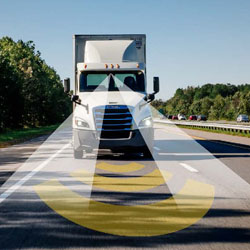Active Safety Systems Play Vital Role in Mitigating Risk

If you could invest in something that would save lives and save your company money, would you? Of course you would, and with the continuous evolution of new active safety technologies available on newer trucks, you can.
Multiple studies recently found that active safety systems, which are comprised of video-based technologies and radar systems, can have a significant impact on the health and safety of today’s truck drivers and those sharing the road with them. Specifically, a recent study by the AAA Foundation for Traffic Safety concluded that furnishing large commercial vehicles with crash-avoidance technology has the potential to prevent up to 63,000 truck-related accidents each year.
Crash Repercussions Go Beyond Immediate Financial Damage
Vehicles involved in accidents create quantifiable costs, such as cargo and vehicle damage, injury expenses, revenue loss due to vehicle downtime, administrative costs, potential for rising insurance premiums and towing costs. But there are significant hidden expenses as well. The less obvious costs may include the potential for lost customers who are impacted by the crash, employee disability costs, legal expenses and reputational risk.
According to a study conducted by the U.S. Department of Transportation (USDOT), the National Center for Statistics and Analysis (NCSA) and the National Highway Traffic Safety Administration (NHTSA), the average costs associated with a commercial truck accident is roughly $59,150. In addition, a 2016 CDC report highlighted that work-related collisions cost U.S. employers $25 billion dollars, which is broken down as $671,000 per death and $65,000 for a non-fatal injury.
"It takes 20 years to build a reputation and five minutes to ruin it."
—Warren Buffett
With each accident, your brand reputation is on public display. Whether the accident makes the 6 o’clock news or becomes a social media sensation, the opportunity for negative publicity due to a crash increases with each accident. And while the overall ROI of safety technology may be difficult to quantify, comparing the cost of a system to the costs associated with a potential accident may be the best indicator. When you add up the costs, you can see how the reduction of downtime, increase in employee and public safety, reduction of property damage, and reducing the total cost of ownership are more cost-effective approaches to a safety program than hoping an accident doesn’t occur. All of this provides a very clear ROI when investing in safety technology.
Make Safety a Priority
As more and more commercial truck drivers experience technology in their family vehicles, the expectation will be that safety technology crosses over into all vehicles they operate. Failing to adapt your fleet to the latest safety technology may send the wrong message — that safety isn’t a priority at your organization.
Over-the-road vehicles continue to deliver products and services all over the world. Fortunately, with today’s vehicles becoming smarter and safer with the help of advanced technology, the tools to improve driver safety continue to expand as well. Some private fleet operators might hesitate to invest in new technology — but it may be more expensive not to in the long run.
With so much at stake, Penske’s latest trucks and tractors can be equipped with active safety systems. These technologies help to mitigate accident expense and any liability associated with it.
Active Safety Systems in Detail
Active safety systems are comprised of technologies such as lane departure warning systems, electronic stability control, video monitoring systems, automatic braking and air disc brakes. A definition of each function, as well as the potential impact each could have, is detailed below.
Lane Departure Warning System – A lane departure warning system is a mechanism designed to warn the driver when the vehicle begins to move out of its lane (unless a turn signal is on in that direction). According to the AAA study, lane departure warning systems could potentially avert up to 6,372 crashes, prevent 1,342 injuries and eliminate 115 deaths per year.
Electronic Stability Control – Works to minimize rollovers and crashes involving loss of control, which NHTSA said are responsible for 304 fatalities and 2,738 injuries on average each year. If the systems detect a vehicle is reaching its critical stability threshold, the technology kicks in and automatically reduces engine torque, applies the engine brake and activates the necessary wheel-end brakes, which reduces the likelihood of a rollover, jackknife or loss of control.
Video-Based Onboard Safety Systems – Designed to both monitor and improve the driving behavior of truck drivers, video monitoring systems can prevent as many as 63,000 crashes, 17,733 injuries and 293 deaths each year, according to the AAA report.
Automatic Braking – Automatic braking is safety technology that spontaneously activates the vehicle’s brake system when sensors monitor the presence of vehicles ahead and around the vehicle or detect any situation where there’s an impending collision. According to the Insurance Institute for Highway Safety, automatic braking, or brake assist, is an integral component of crash avoidance technology. AAA states that automatic braking can prevent up to 5,294 crashes, 2,753 injuries and 55 deaths per year.
Air Disc Brakes – Designed to improve the stopping distance of a vehicle, air disc brakes can prevent up to 2,411 crashes, 1,447 injuries and 37 deaths each year, according to the AAA study.
Penske is, and will continue to be, at the forefront of safety technology, enabling fleets and carriers to operate more efficiently, improving customer service and safeguarding your organization’s reputation and bottom line.
October 2017

